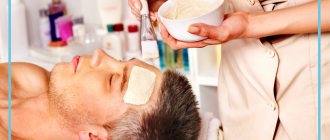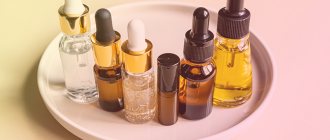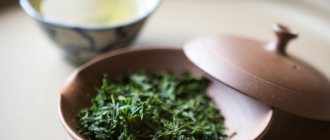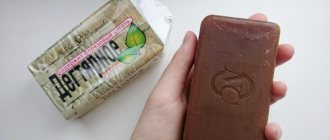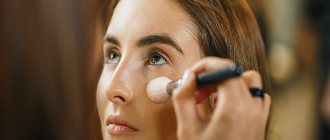How to correctly determine your facial skin type? How many tests are there to determine skin type and does the selection of cosmetics depend on their results? What care products are suitable for a particular skin type? Let's test your skin together!
What are the types of facial skin? How to determine your skin type: visual signs How to find out your skin type: wipe test Test for skin type, taking into account its reactions Care for different skin types
What are the types of facial skin?
There are four main types of facial skin (we will look at them in detail below):
- normal;
- dry;
- fat;
- combined.
Additionally, sensitive and problem skin is also distinguished - however, this is not a skin type, but rather an additional or temporary characteristic of it. Skin of any type can be sensitive (sharply reacts to external factors) and problematic (prone to the appearance of imperfections and rashes).
Dry skin
Those with dry skin are quite easy to identify. Their skin looks thin, resembles porcelain or parchment in tone (depending on its natural tone), and is prone to dehydration, flaking and the early appearance of wrinkles.
This is due to the fact that dry skin may be characterized by a deficiency of lipids (fatty structures) - the most important “building blocks” from which the protective barrier (hydrolipid mantle) of the skin is formed. A “weak” hydrolipidic barrier leads to the fact that the skin does not retain moisture well, quickly dehydrates and is susceptible to early aging.
Oily skin
Oily skin is characterized by increased shine, enlarged pores, blackheads, acne and other imperfections. It is oily skin that is most often called problematic - to some extent, this is true.
This skin condition is associated with the active work of the sebaceous glands, which excessively produce sebum (sebum). It, in turn, “clogs” the pores and prevents the skin from self-cleansing, causing acne and other rashes to appear.
Combination skin
This type of skin can be shiny in the T-zone (forehead, nose and chin) but prone to dryness and flaking in the cheekbones and cheeks. It is important to understand that combination skin can be both problematic (especially in the nose and chin area) and prone to lipid deficiency (and dehydration).
For those with combination skin, it is better to look for cosmetics labeled accordingly, or select separate products for each area of the face. When choosing “universal” products, it is important to monitor the absence of unwanted reactions to cosmetics on all areas of the face.
Normal skin
It would seem that women with a normal skin type can only be envied... However, behind the “calming” name the same problems can be hidden: reduced protective functions, increased sensitivity, a tendency to early aging or reactions to aggressive environmental influences...
True, if for dry or oily skin the causes of such problems lie in the area of internal processes, then normal skin is more likely to react in a similar way to incorrectly selected care or neglect of regular beauty procedures.
Test yourself
If you cannot immediately determine your skin type, a small test will help you. You will need good lighting, a mirror, and cosmetic wipes.
Wash your face or use cosmetic milk. Look carefully at your face in the mirror.
After 2 hours, repeat the inspection and choose your answers to 6 questions
- You look in the mirror. Pores of your skin:
- Almost invisible
- Small, but still visible
- Extended in the area of the nose, forehead
- Large
- Apply a cosmetic tissue to your cheek, nose, forehead, chin:
- No greasy marks
- Light prints, almost indistinguishable
- There are prints left from the nose, chin, forehead
- Clear fingerprints from every touch
- The skin tightens and there is a feeling of dryness
- The face is smooth, there are no unpleasant sensations
- In some areas the skin is smooth, in others it is flaky
- Pleasant feeling of freshness
- Tight, slightly itchy
- Fresh, clean
- Shiny on the forehead, and (or) nose, chin
- Oily in almost all areas of the face
- Never
- Very rarely, usually once a month
- Sometimes on the forehead, nose, chin
- Often
- The skin becomes very dry, chapped and flaky in winter.
- The skin tolerates heat and cold equally, it becomes a little drier in winter
- Skin becomes oilier in summer than in winter
- The skin tolerates winter well, but in summer pimples and blackheads appear much more often.
How to determine your skin type: visual signs
How to quickly find out your facial skin type? An express test to determine your facial skin type based on its description may be suitable for this:
- Dry skin: dull, flabby, prone to flaking and the appearance of fine wrinkles.
- Oily skin: evenly shiny in all areas, enlarged pores, prone to blackheads.
- Combination skin: areas of shine and dryness are unevenly distributed, there are rashes and blackheads, some areas may peel.
- Normal skin: the skin is “clean”, there are usually no pronounced problems, isolated episodes of rashes or dryness are possible, usually associated with some external factors.
Of course, this rapid test does not pretend to be maximum accuracy - rather, it is a first acquaintance with the topic. If you want to try to figure out how to understand what skin type you have more accurately, move on to our next tests. In addition, to be confident in the results obtained and to accurately determine your skin type, we recommend that you seek a face-to-face consultation with a specialist.
Some interesting facts about human facial skin
- We are born and die with the same skin type. Genetics plays a role here, not care.
- The skin cannot be both dry and oily. The feeling is created due to improper care.
- Skin may get better or worse with home care, but it will not change from type to type.
- 90% of people fundamentally take care of their skin incorrectly, and it is home care that is responsible for beauty and youth, and not for the natural stages of aging.
- We will analyze each stage, the main thing is not to run ahead of the locomotive.
How to find out your skin type: tissue test
How can you tell what kind of skin you have using a regular paper napkin? To do this you need to follow a few simple steps:
- Cleanse the skin with a mild product that is familiar to it: gel or foam cleanser.
- Dry your face carefully with a towel or cloth without rubbing the skin.
- Wait about an hour - during this time you cannot use any cosmetic products.
- Place a thin paper napkin on your face and gently press it onto your forehead, nose, cheeks and chin.
Hold for a minute and evaluate the results:
- Clear, clearly visible grease stains over the entire area of the napkin indicate oily skin.
- Light traces of sebum are barely noticeable and are also distributed over the entire surface of the napkin - the skin is normal.
- The marks are clearly visible only in the T-zone - combination skin.
- There is no discharge on the napkin at all, the surface is clean - the skin is dry.
Disadvantages of this classification
Modern cosmetology does not rely on this classification, because it is too arbitrary and does not take into account many other features of the skin. For example, the characteristics of the skin renewal process.
Let's say a woman has dry skin, but the peeling of horny scales is slow. If you begin to intensively lubricate such skin with a rich cream, taking into account only the dryness of the skin, then it will glue the horny scales and prevent them from peeling off from the surface of the epidermis. This will lead to deterioration of the skin condition, possibly even to the appearance of pimples and blackheads.
And yet, despite the conventions, it will not be superfluous to determine your skin type.
Firstly, it is convenient for both cosmetics consumers, manufacturers, and cosmetologists.
Secondly, any skin still has certain characteristics associated with this classification. These characteristics can be taken as a basis when choosing cosmetics.
Test for skin type taking into account its reactions
How to determine your facial skin type if it is not possible to do a test with a napkin? You can answer a few simple questions to help assess your skin condition and type.
Describe the normal condition of your skin:
- Sluggish, reduced elasticity, prone to flaking, dull complexion, skin looks thin.
- It has a constant shine, the pores are enlarged, and is prone to the appearance of blackheads and rashes.
- It shines unevenly (usually in the T-zone); blackheads and slight flaking may appear.
- Matte, pleasant to the touch, no redness, blackheads, or greasy shine.
Are there any “habitual” skin problems that occur regularly?
- After being outside (in the sun, wind or frost) or under the influence of other factors, the skin looks tired, begins to peel, and the first wrinkles are more clearly visible.
- The skin is constantly shiny and looks “untidy”, the pores are enlarged, and blackheads and rashes often appear.
- Even with general good condition, rashes regularly appear on the chin or on the wings of the nose.
- With regular care there are no special problems.
How does the skin react to washing with water and its usual products?
- It’s uncomfortable to wash your face with clean water, it creates a feeling of tightness – you have to use foam or soft gel every time.
- It’s as if the skin doesn’t notice the washing – the shine and feeling of oiliness return almost immediately.
- It is not always possible to choose the right product - areas of the face react differently, and you have to use several beauty products.
- The skin reacts calmly to any product, no special problems were noticed.
Tell us, by what principle do you select skincare products?
- Thick, dense, rich products are best for the skin - after them the skin seems to come to life.
- I try to choose products with the lightest possible texture: gels, lotions, foams, tonics...
- According to the principle of zoning: each area of the face has its own product.
- I just go by the composition and the desired effect on the skin, I don’t pay attention to the texture and density.
How to understand what type of skin is the result? Rate which options you chose most often:
- Mostly option A – dry skin.
- Preferably option B – oily skin.
- Preferably option C – combination skin.
- Mostly option D – normal skin.
Dehydrated skin
Dehydration is a skin condition caused by a lack of moisture. We have already talked about the dry type of skin, that it is thin, porcelain, its pores are practically invisible, and blood vessels are visible through it. 80% of those with oily and combination skin, despite the oily shine and enlarged pores, continue to feel tight, dry and flaky. The first thing you should make sure is that the skin is dehydrated and not dry.
The most obvious signs of dehydration
- Tightness after contact with water. I would like to quickly apply the cream to relieve discomfort.
- Skin roughness. Peeling appears, which characterizes the last degree of dehydration.
- Most often, dehydration occurs due to the fact that we wash away the protective fat layer. This is especially true for lovers of laundry, tar or African soap. The highest measure of my love extends to those who adore Dove soap.
Reasons that can cause dehydration
- Too aggressive cleansing.
- Using harsh gels to wash the face, especially for oily and combination skin, we wash away the protective lipid layer, the glands themselves begin to work more actively in order to replenish the lack of moisture, the skin becomes even more oily, and a vicious circle results.
- Poorly selected cleansers and makeup removers.
- Cosmetics that do not match your skin type.
- Aggressive peelings.
- Excessive use of acids.
- Abuse of patches
- And drying masks.
- And, of course, water, we forget that the average fluid requirement is 1.5 liters of water per day. Tea, coffee, compote do not count.
With dehydrated skin, literally by the middle of the day, you will notice that the foundation has rolled off, and pigment remains in pieces on the skin. This happens because the skin has absorbed all the moisture from the foundation. Because she's thirsty!
Dehydrated skin ages faster than usual and does not respond well to anti-aging creams and serums, which, of course, affects the production of collagen and elastin.
We will definitely talk about how to restore moisture to the skin, remove dullness and dullness.
Photo example of advanced dehydration:
Care for different skin types
Once you have determined what type of facial skin you have, you need to figure out how to properly care for your skin depending on its type? We offer you a selection of tips and recommendations.
Dry skin care
It is very important to provide dry skin with intense hydration and gentle, gentle cleansing. It is important that care products help restore the skin's hydrolipid barrier, help it retain moisture and maintain its protective functions.
The following Cerave products may be suitable for this:
CeraVe Moisturizing Cleansing Cream-Gel for normal to dry skin: it gently cleanses the skin and gently removes traces of dirt and makeup. In addition, glycerin and hyaluronic acid included in the product help moisturize the skin after the first use.
CeraVe Moisturizing Cream for Dry to Very Dry Skin: A rich yet non-greasy cream with hyaluronic acid and glycerin that helps provide long-lasting hydration throughout the day. It also contains ceramides, phytosphingosine and cholesterol, which help restore and strengthen the skin's protective barrier.
Moisturizing cream
For dry to very dry skin of the face and body
Provides long-lasting hydration throughout the day, restoring and strengthening the protective skin barrier.
More details
Oily skin care
Oily skin, on the contrary, needs intensive (but gentle) cleansing and light moisturizing. It is recommended to ensure that cleansers do not disturb the hydrolipid balance of the skin and do not cause it to “overdry”.
The following Cerave products may be suitable for this:
CeraVe Intensive Cleansing Gel for normal to oily skin: it effectively cleanses the skin, removing not only traces of dirt, but also excess sebum - without damaging the skin's protective barrier. In addition to ceramides and hyaluronic acid, the gel contains niacinamide, which helps soothe the skin.
Intensively cleansing gel
For normal to oily skin of the face and body
Deeply cleanses and refreshes the skin, removing excess sebum and impurities.
More details
In addition, oily skin also needs hydration, just like any other skin type. Don’t fall for the myth that oily skin only needs to be “dried out.” Choose moisturizers that are suitable for her and light in texture and include them in your daily beauty routine.
Combination skin care
It is better to select products for the care of such skin depending on its current needs. For example, in winter, combination skin can dry out and need increased hydration; in summer, it can become problematic and prone to rashes (especially in the T-zone).
For cleansing, you may want to consider a generic moisturizer, such as CeraVe Hydrating Micellar Cleansing Water for All Skin Types. It helps to carefully cleanse the skin of traces of cosmetics and impurities, moisturize it and strengthen the protective barrier. CeraVe Micellar Water contains ceramides, glycerin and niacinamide and is hypoallergenic and non-comedogenic.
Hydrating Cleansing Micellar Water
For all skin types
Gently cleanses of cosmetics and impurities.
295 ml
More details
Why does the type change over time?
Over the course of a lifetime, your skin type can change several times. The first changes occur during puberty, when the work of the sebaceous glands intensifies. As a result, it can become oily or problematic.
In older age, the skin produces less sebum. Therefore, the normal and dry type is more common. Collagen production also decreases, leading to decreased firmness. As a result, the skin begins to fade and the first signs of aging appear.
In addition, the type is affected by care. The skin becomes dehydrated due to lack of hydration. And due to cosmetic procedures or past illnesses, sensitivity may increase.
To determine your skin type, it is not at all necessary to contact a specialist. It is enough to choose 1-2 convenient methods and conduct the test yourself. However, it is worth considering that there may be an error in the results. To be sure of the accuracy, it is recommended to consult a specialist who will determine your skin type and give recommendations for care.
Rotation test to determine the first signs of approaching aging
What do we have to do? Everything is very simple. You should rotate your thumb by placing it in the middle of your cheek and pressing down a little. The result can be assessed immediately:
- If the skin resists rotation, then there is nothing to worry about, the test is negative, and there are no primary symptoms of aging.
- A network of wrinkles appears and disappears - this effect indicates that signs of aging have already appeared.
- If the skin curls quite easily, without the slightest resistance, and the movement leaves behind a trail of wrinkles, then this indicates that the process of “fading” is underway, and in full swing.
How to find out the nature of skin tone on the face
Skin tone is its general condition and appearance. This concept consists of several others, such as turgor, elasticity, and so on.
The test is very simple. You need to squeeze your face with your fingers on your cheek. Of course, the easier this test is, the worse the tone, but still here are some small explanations:
- If the fold cannot be captured, then this is a healthy tone .
- A fold forms, but not for long, the skin quickly returns to its normal state - the tone is good, but the skin is a little flaccid .
- The fold is very easy to form and is maintained without problems - the tone is quite low with flabby, flabby skin .


